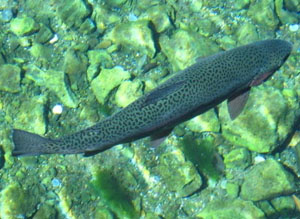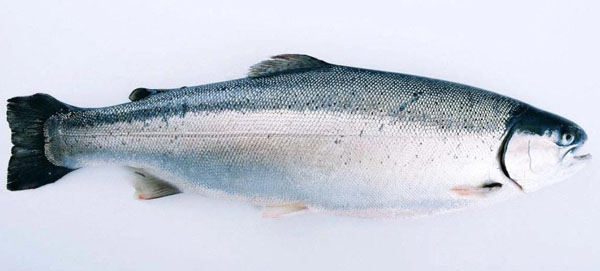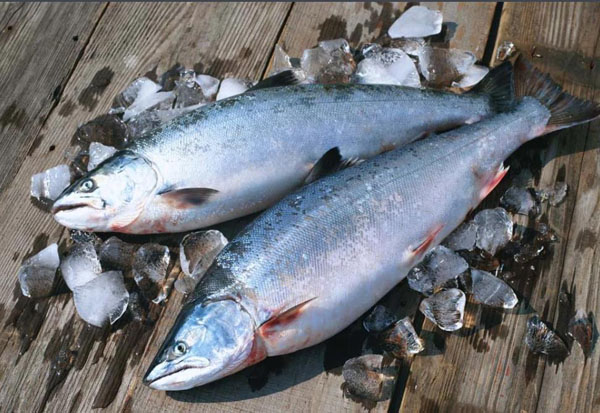
Alias Salmo salar,Kennebec salmon、Sebago salmon,Northern trout, king salmon, hunchback, salmon, mackerel, salmon, salmon
Family Salmoniformes Salmonidae Salmon
There are more than 30 species of salmon with commercial value. The most common ones are 2 types of trout (salmon trout and golden trout) and 4 types of salmon (Pacific salmon, Atlantic salmon, Arctic white char, and silver salmon).
Salmon is a cold-water fish. Originally inhabiting the northern Pacific Ocean, it migrates in groups in summer or autumn for reproduction after living in the ocean for 3 to 5 years (usually reaching sexual maturity at 4 years old). It can be divided into two biological groups according to the time of upstream migration, summer type and autumn type. Only the autumn type goes upstream into the Heilongjiang River in China. Most of them spawn in the lower reaches, and only a few reach the upper reaches to spawn. They go up the river, day and night, and work tirelessly. They can advance 30-35 kilometers every day and night. No matter whether they encounter shallow canyons or rapids and waterfalls, they will not retreat and rush through many obstacles until they reach their destination. Adult fish will not eat after entering the freshwater reproduction period.

According to scientific research institutions in China and Norway, eating salmon regularly can reduce the incidence of cardiovascular and cerebrovascular diseases. Salmon is rich in omega-3 highly unsaturated fatty acids, which can effectively prevent cardiovascular and cerebrovascular diseases and have a positive effect on brain tissue health.
Precautions for eating salmon
Wild salmon has more parasites, with Anisakis being the most common, which can easily cause abdominal pain and diarrhea, but seawater parasites cannot survive in the human body for a long time. In comparison, farmed salmon may have fewer parasites. It is worth noting that freshwater farmed rainbow trout is sometimes used for sashimi, but its risk is much greater than salmon. This is because parasites in freshwater fish can survive in the human body, the most common of which is liver fluke. Therefore, freshwater farmed rainbow trout cannot be eaten raw. Anisakids can be frozen to death. The Shanghai Food and Drug Administration recommends freezing at minus 20℃ for more than 24 hours or freezing at minus 35℃ for 15 hours in accordance with foreign standards.
Orange-red meat color
Wild salmon feed on seaweed, fish and shrimp, and the astaxanthin in their bodies gives salmon a beautiful orange-red color. In addition to eating small fish and shrimp, farmed salmon are also fed protein, fish oil, etc., which makes astaxanthin insufficient and the meat color tends to turn white. In order to improve the sensory quality of fish, breeders often feed farmed salmon with a feed additive-canthaxanthin, which makes its meat color natural orange-red. However, consumers do not need to worry. Canthaxanthin is a carotenoid that exists naturally in many foods, such as mushrooms. Since the amount added is very small, canthaxanthin does not pose a threat to health. The European Union, the United States and the International Food Code all consider it safe.

Differences between wild and farmed salmon
The competition in the wild salmon living environment is very fierce. They have to work hard to survive. They can only mature after 3 years. Therefore, they have well-developed muscle tissue, less fat content, soft and firm meat, and a feeling of eating lean meat; farmed salmon lack natural competition environment and exercise space. The feed is composed of high fat and high protein. Generally, they are fat and strong. They can grow to more than 20 kilograms in less than 1 year. The fish body is fat and tender and rich in fat. You can see very obvious white fat lines on the fish meat, and the taste is relatively soft. The nutrition of wild salmon is slightly higher than that of farmed salmon. Experimental tests have found that farmed salmon is also nutritious, with a comprehensive amino acid composition, and a high total amount of essential amino acids and a high mass fraction of flavor amino acids. It is a food with high nutritional value.